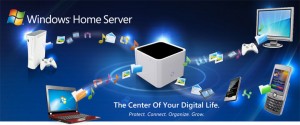So I finally got around to upgrading my second file server. I had upgraded my Linux file server from 6x500GB to 6x1TB (RAID5) when Windows 7 got released. I remember taking 2 of the 500GBs and using them in my main desktop (RAID0). However, I had a 2nd file server (original file server before I built the Linux one). The 2nd file server was running Windows Server 2003 and had 4x160GB (RAID5).
Jeremy had asked if I had any spare hdds because he needed one to diagnose his computer issues. I did have the 4 spare 500GBs, but I figured I could probably swap them out from my Windows file server and give Jeremy a 160GB instead. So the first thing I had to do was to copy all the files off the old file server (there was about 400GB worth of data and my Linux file server had about 600GB of free space). While copying the files, my Windows RAID5 array fails. I decided to run it in degraded mode and just copy the remaining files. I was glad the attempt was successful.
So I’ve been meaning to upgrade to Windows Home Server for some time since I’ve heard there were some good user experiences with computer backups and media center. I got my copy off MSDN and began installing it. I was shocked when after the 1st reboot, it showed that it was booting/installing Windows Server 2003. I found out later that Windows Home Server was built on top of Windows Server 2003. I had always assumed it was built on top of Windows Server 2008 for some reason.
Do note this is a pretty slow machine (AMD Athlon XP 2400+ with like 1GB of RAM), so the OS installation took some time. Everything went through pretty smoothly, but I had some questions about setting it up. Thanks to Matt for providing some tips on how to use it. I wasn’t sure what anti-virus/malware software I should use. Microsoft Security Essentials doesn’t run on Windows Server and there’s no free version of AV software that runs on Windows Server either. A search online had people recommending avast! Windows Home Server Edition, but I decided to run it without anti-virus protection for now since people wouldn’t t be using the machine directly.
I also wasn’t sure if I should be adding the hdds as Storage or Backup drives. I had enabled duplication on certain folders, but Matt confirmed that the Storage drive option is what I want for everything. Duplication will still occur. Backup drives are apparently for a different purpose. And there’s no need to RAID these hdds and you only need to backup what you really care about. Even though Windows sees them as separate hdds, to the user it’s treated as 1 giant partition as Windows does all the magic behind the scenes, so there’s no hassle of trying to decide which drive to put what.
Another good thing about Windows Home Server is that there is no complicated process if you want to upgrade the hdds. It uses everything you can throw at it, including external drives. Though I did read somewhere that you probably want to wait a day or 2 between drive upgrades to allow all the duplication to occur correctly.
Now it comes to the fun part!
Backups
Windows Home Server comes with a client connection software, which registers your machine with Windows Home Server and it’ll automatically backup your machine during the specified time. You can configure it to ignore particular folders and it already has a default set of files/folders to ignore. It even has the ability to wake up the machine for backup purposes if the machine is asleep. By default it keeps the last 3 daily backups, the last 3 weekly backups, and the last 3 monthly backups.
Sharing Media Files
Any computer that registers with with the server automatically adds a certain set of shared folders (e.g. Photos, Music, Videos, etc.) to its library, making sharing media content extremely easy. Previously you would have to manually map network shares and so on.
Media Center Integration
There’s even media center integration which allows you to not only view TV recordings that are on the server, but also automatically archive (compression optional) to the media server, which I found really spiffy.
All in all, I’m really happy with Windows Home Server.

